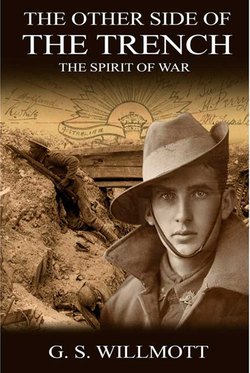The Other Side of the Trench

Реклама. ООО «ЛитРес», ИНН: 7719571260.
Оглавление
G. S. Willmott. The Other Side of the Trench
Table of Contents
Introduction
War
You Never Know Who You Might Meet. in No-Man’s Land
Victoria Dock to Prince’s Park
Love and War
Family Reunion
Gallipoli
From Desert to the Green Hills of France
Ancestry.com
Not so Gay Paris - 1914
Gay Paris - 2012
Tour de France
From Here to Eternity
Attack or not to Attack
We Will Fight Them in the Trenches
The Aftermath
A Farmer’s Dilemma
Ours in not to Question Why. Ours is but to do or Die
The Agony and the Passion
Ghosts
They Heard the Blasts in London
United We Stand United We Fall
Passchendaele
The Innocents of War
The Dogs of War
War Horse
Blood Sweat and Tears
French Blood Flowed Like a River
School Days
Snakes and Ladders
Monash’s Blitzkrieg
Letters From the Front
How Are You Going to Keep Them Down. On Mouquet Farm
Uncle Sam Joins the Fray
“Retreat! We Just Got Here”
ANZAC Day 2012
Bring In The Storm Troopers
The Beginning of the End
Spanish Flu
The Spirit of War
Epilogue
BIBLIOGRAPHY
Win a Trip to France and Belgium
Отрывок из книги
Chapter 1– WAR
Chapter 2 – You Never Know Who You May Meet
.....
The five divisions of the AIF, now organised into the Australian Corps, had spent the winter of 1917–18 in Belgium. As this new crisis developed on the Somme, Australian units were hurried south to help hold back the German advance. On 27th March, 1918, elements of the Fourth Division took up positions around Dernancourt. This village on the River Ancre is on the southwest outskirts of Albert, which had been occupied by the Germans. On the 28th of March, the Germans attempted to resume their advance. In the morning mist, the Germans emerged from Albert along the railway line.
On that day, fighting spread along the whole front between Dernancourt and Albert. The 48th Battalion (South Australia and Western Australia) and the 12th Machine Gun Company supporting a British unit were attacked but all attacks were beaten back. British and Australian artillery interfered with German attempts to rally troops and to bring forward support troops for further assaults. One German attempt to mount an attack was ruined by what Charles Bean, the Australian official historian, called ‘a rather strange occurrence’. As the Germans were massing for the attack, a chance shell caused an old British ammunition dump to explode. The noise was deafening and the Germans scattered. By this time the Australians, who had had three days and three nights of moving, marching, digging, fighting and little sleep, were nearly exhausted. However, rain, which began with a drizzle in late afternoon, became heavier during the night and made further German attacks unlikely. The Australians were soon withdrawn from the line for a rest. The rest did not last for long.
.....